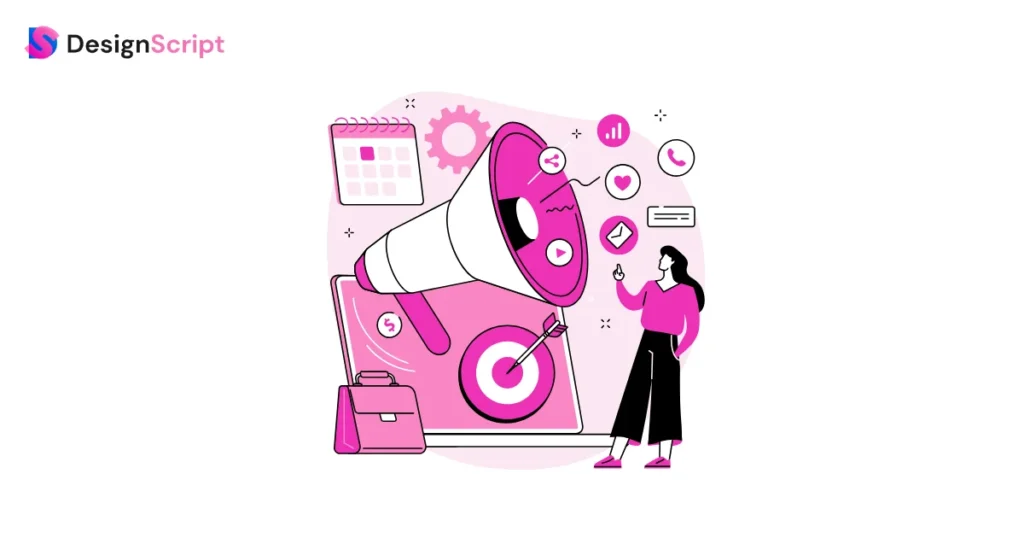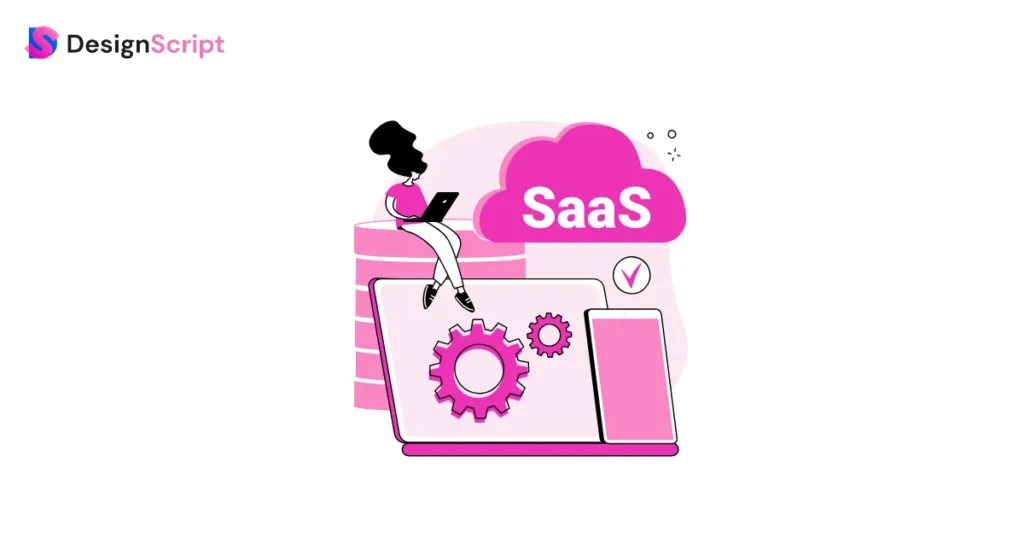The Complete SaaS Content Marketing Guide
Did you know that 92% of SaaS (Software as a Service) companies utilize content marketing to grow their businesses? That’s because SaaS Content Marketing is not just an option; it’s necessary in today’s digital landscape.
Without a solid content marketing strategy, businesses can find themselves lost in the vast online ocean, facing challenges in converting target audiences.
So are you wondering what you can do as a SaaS business owner?
We’re here for you. Get ready to explore the world of SaaS content marketing in this blog post, where we’ll provide you with the tools, insights, and strategies you need to stand out in the competitive SaaS landscape.
So, let’s begin this journey together and unlock the full potential through this SaaS Content Marketing Guide!
Table of Contents
- What is SaaS content marketing?
- How is SaaS Content Marketing Different?
- Why Is Content Marketing Essential For SaaS Companies?
- Creating an Effective SaaS Content Marketing Strategy
- SaaS Content Marketing Metrics
- 1. Unique Pageviews
- 2. Social Media Interactions
- 3. Followers/Subscribers
- 4. Bounce Rate
- 5. Click-Through Rate (CTR)
- 6. Conversion Rate
- 7. Exit Rate
- 8. Monthly Recurring Revenue (MRR)
- 9. Customer Acquisition Cost (CAC)
- 10. Sales Cycle Length
- 11. Customer Retention Rate (CRR)
- 12. Churn Rate
- 13. Customer Lifetime Value (CLV)
- Best Practices for SaaS Content Marketing
- B2B SaaS Buyer’s Journey
- Examples of Brilliant SaaS Content Marketing
- FAQs
What is SaaS content marketing?
SaaS content marketing is a specialized form of content marketing tailored for SaaS companies. It’s all about using valuable and relevant content to promote and grow SaaS businesses.
Further, content marketing is a marketing strategy that involves developing and sharing content (like blog posts, videos, infographics, and more) to engage with your target audience, provide them with useful information, and, ultimately, persuade them to become customers.
When discussing SaaS content marketing, we focus on content strategies and tactics that benefit SaaS companies. These businesses sell software solutions that are often cloud-based and subscription-based, like productivity tools, CRM software, or project management apps.
A robust SaaS content marketing strategy understands the unique needs of these companies. It focuses on educating potential customers about the software’s benefits, showcasing its features, and addressing common pain points in the industry.
By crafting content that speaks directly to SaaS users’ challenges and how your software can solve them, you’re more likely to attract and retain customers. It’s not just about selling; it’s about building trust and demonstrating expertise.
Therefore, SaaS content marketing is the key to creating a strong online presence for SaaS companies, converting curious visitors into loyal subscribers, and paying users of their software solutions.
How is SaaS Content Marketing Different?

Now, in this SaaS content marketing Guide, we will explore the difference between regular content marketing and SaaS content marketing:
1. Specific Audience
SaaS content marketing targets a specific audience – people interested in software solutions. The content must be tailored to address SaaS users’ unique needs and challenges.
2. Address Pain Points
The SaaS content marketing strategy is about identifying and addressing potential customers’ pain points. It aims to show how a particular SaaS product can solve these problems effectively.
3. Educational Focus
SaaS marketing is often educational. It’s about teaching users how to use the software effectively and get the most out of it. This educational approach is crucial for building trust and loyalty.
4. Content Ideas
Creating content for SaaS requires different content ideas. It might include how-to guides, software tutorials, case studies, and comparisons with other similar tools.
5. Brand Awareness
SaaS content marketing also creates brand awareness within the software niche. It’s not just about selling a product; it’s about establishing the brand as a trusted authority in the industry.
6. Social Media
While regular content marketing might focus on a broad social media approach, SaaS content marketing tends to be more selective, targeting platforms where SaaS users are likely to hang out, like LinkedIn or tech-specific forums.
So, SaaS content marketing is like speaking the language of software users. It’s about figuring out what bothers them and showing how your software can improve their lives.
Why Is Content Marketing Essential For SaaS Companies?

In this SaaS Content Marketing Guide, we will learn why content marketing is crucial for SaaS (Software as a Service) companies:
1. Educating Customers
Content marketing allows SaaS companies to educate potential customers about their software’s features and benefits. It helps users understand how the software can resolve problems and make their lives easier.
2. Building Trust
SaaS companies can build trust with their audience by giving information and addressing pain points through content. Customers are more likely to choose a software provider they trust.
3. Establishing Authority
Creating high-quality content positions SaaS companies as experts in their field. This authority can attract a larger audience and make customers more confident in their choices.
4. Increasing Visibility
Effective content marketing efforts improve a company’s online visibility. When content is fine-tuned for search engines, it can rank higher in search results, bringing more organic traffic.
5. Lead Generation
Content can be used to capture leads. SaaS companies can offer valuable resources like ebooks, webinars, or free trials in exchange for user information, helping grow their customer base.
6. Reducing Churn
Addressing common pain points through content can help reduce customer churn. Users who know how to make the most of the tool are less likely to switch to a competitor.
7. Engaging Existing Customers
Content isn’t just for acquiring new customers; it’s also for retaining existing ones. Regular updates and helpful tips keep customers engaged and satisfied.
8. Staying Competitive
In the competitive SaaS landscape, a well-executed content strategy can set a company apart from rivals who may not effectively communicate their value.
Content marketing for SaaS companies is about creating a comprehensive content strategy that speaks directly to their target audience’s needs and pain points. It’s a powerful tool for educating, engaging, and converting potential customers while retaining and satisfying existing ones.
Creating an Effective SaaS Content Marketing Strategy
A good SaaS content marketing strategy is like a roadmap guiding your efforts to reach and engage your audience. Simply put, it’s a plan that helps you talk to the right people and interest them in your software. Let’s break down the steps to create an effective SaaS content marketing strategy in this SaaS content marketing guide:
1. Define Your Goals

First, you need to know what you want to achieve with your content. Are you aiming to increase brand awareness or boost sales? Setting clear content marketing goals helps you stay on track.
Imagine you’re going on a road trip. You need to know your destination to plan your route effectively. Similarly, your content marketing goals give you direction. Are you driving to boost sales or take the scenic route of brand building? Knowing your destination helps you choose the right path.
2. Define Your Metrics

Once you’ve set your goals, figuring out how to measure your progress is important. Metrics like website traffic, conversion rates, and social media engagement are essential for tracking your success.
Metrics are like the signposts on your journey. They tell you if you’re headed in the right direction. To increase website traffic, you have to track metrics like the number of visitors. If it’s lead generation, monitor the number of sign-ups. Metrics help you gauge your progress and make adjustments if needed.
3. Define the Ideal Customer Profile

Who are you trying to reach with your content? Creating an informative profile of your ideal customer helps you promote your content based on their needs and preferences. It’s like speaking directly to them.
Create a detailed profile, including demographics, interests, and pain points. It helps you develop content that resonates with them.
4. Audit Existing Content

Take a close look at the content you already have. What’s working? What’s not? Identify gaps and opportunities to improve. This step is like cleaning out your closet – you want to keep what’s useful and toss what’s not.
It’s like cleaning out your car before the trip. Review your existing content to see what’s useful and what’s outdated. This step helps you identify gaps and opportunities in your SaaS content strategy.
5. Match Your Style with Your Brand

The content should reflect your brand’s personality and values. Whether formal and professional or casual and friendly, consistency in your writing style helps build trust with your audience.
Your brand is like your vehicle. It should be consistent and reliable. Ensure your content’s tone, style, and messaging align with your brand identity. This consistency builds trust with your audience, just like a well-maintained car inspires confidence on a road trip.
6. Document Your Strategy

Finally, document your plan. Think of it as your itinerary. Outline the types of content you’ll create, where you’ll share it (your content distribution channels), and how often you’ll publish. Having a clear content marketing plan keeps you organized and accountable.
Therefore, creating an effective SaaS content marketing strategy involves all the above steps. With these steps in place, you’re well-prepared for your content marketing journey and are better equipped to navigate the ever-evolving digital marketing landscape.
SaaS Content Marketing Metrics
Let’s break down some SaaS content marketing metrics in this SaaS content marketing guide:
1. Unique Pageviews
Unique pageviews measure the number of visitors who view a specific page on your website. It helps you understand how engaging and valuable your content is to your audience.
2. Social Media Interactions
Social media interactions encompass comments, likes and other forms of engagement on your content shared across various social platforms. These interactions reflect the interest and interaction your content generates on social media channels. Many interactions indicate that your content is relevant and shareable, increasing its potential reach.
3. Followers/Subscribers
Followers and subscribers represent the audience who actively chooses to receive updates from your SaaS company, typically through email subscriptions, social media follows, or blog subscriptions. This metric reflects the size and loyalty of your audience. A growing follower/subscriber count suggests that your content marketing efforts effectively attract and retain an interested audience.
4. Bounce Rate
It measures the number of visitors who go away from your website after viewing only one page, indicating a lack of engagement. In content marketing, a high bounce rate may suggest that your content does not align with visitor expectations or fails to provide the information they seek.
5. Click-Through Rate (CTR)
CTR measures the percentage of users who click on a specific link, often in an email or ad campaign, relative to the number of total users who viewed it. It’s a crucial metric for assessing the effectiveness of your call-to-action and content engagement.
6. Conversion Rate
The conversion rate calculates the percentage of users who complete a desired action, such as signing up for a free trial or making a purchase, out of the number of users who interacted with the website or app. It reflects the efficiency of your sales or marketing funnel.
7. Exit Rate
It represents the percentage of users who leave your website or app from a specific page. Unlike bounce rate, exit rate considers users who may have visited multiple pages before deciding to exit. It helps pinpoint where users are dropping off in their customer journey.
8. Monthly Recurring Revenue (MRR)
MRR is the monthly revenue generated from your subscription-based SaaS services. It’s a key metric for tracking revenue growth and forecasting future revenue streams.
9. Customer Acquisition Cost (CAC)
CAC calculates the cost of acquiring a new customer. It includes marketing and sales expenses and is essential for evaluating the efficiency of your customer acquisition strategies.
10. Sales Cycle Length
This metric calculates the average time converting a lead into a paying customer. A shorter sales cycle often indicates a more efficient and effective sales process.
11. Customer Retention Rate (CRR)
CRR calculates the percentage of customers you retain over a specific period. High CRR signifies strong customer loyalty and satisfaction, reducing the need for aggressive customer acquisition efforts.
12. Churn Rate
It is the opposite of the retention rate, representing the percentage of customers who stop using your service or unsubscribe during a given period. Reducing churn is vital for maintaining a healthy SaaS business.
13. Customer Lifetime Value (CLV)
CLV is the predicted revenue a customer will produce throughout their relationship with your company. It helps you determine the long-term value of acquiring and retaining a customer.
These metrics help you understand how well your content marketing is working and whether it’s helping you achieve your content marketing goals, like getting more visitors through organic search, improving your content writing, and ultimately growing your business.
Best Practices for SaaS Content Marketing

In this SaaS content marketing guide, we will explore some simple and effective best practices to follow:
1. Find Topics with Search Traffic Potential
Start by researching topics related to your SaaS product that people are searching for online.
Utilize tools like Google Keyword Planner to find keywords that have the potential to attract search traffic. This way, you can craft content that aligns with what your audience is searching for.
2. Give the Topics You’ve Found a “Business Potential” Score
Not all topics are equal. Some may attract more potential customers than others. Evaluate the business potential of each topic by considering factors like relevance to your product and the size of the target audience.
3. Produce High-Quality Content
Once you’ve identified promising topics, it’s time to create content. Focus on delivering high-quality, informative, and engaging content. Make sure it provides value and addresses the needs of your target audience. High-quality content builds trust and authority.
4. Make Your Content Visible in Google Search
Improve your content for search engines (SEO content) to attract organic traffic. Use relevant keywords strategically within your content, optimize meta tags, and ensure your website is user-friendly and mobile-responsive.
5. Promote the Content
Creating great content is the first step but you also need to promote it. Allocate your content on social media, in email marketing campaigns, and within relevant online communities. It increases its reach and visibility, driving more potential customers to your SaaS website.
6. Monitor Your SaaS Content Marketing Metrics
To increase the effectiveness of your content marketing strategy, it’s crucial to maintain ongoing monitoring of key metrics. Continuously track essential indicators such as conversion rates, website traffic volume, and levels of audience engagement. Thoroughly assess both successful and less effective aspects of your strategy, and be prepared to make necessary adjustments to optimize your approach.
7. Implement a Marketing Funnel
Understand your customer journey. Map out the steps a potential customer takes, from discovering your content to becoming a paying user of your SaaS product. Implement a marketing funnel that guides them through this journey, providing valuable content at each stage to provide leads and convert them into customers.
Thus, SaaS content marketing is essential for the success of your SaaS business. By finding topics with search traffic potential, evaluating their business potential, creating high-quality content, optimizing search engines, promoting your content, and monitoring your metrics, you can build an effective online presence, attract more potential customers, and ultimately grow your SaaS business.
Additionally, implementing a marketing funnel tailored to the customer journey will help guide leads toward becoming loyal users of your SaaS product. Following these best practices will set you on the path to success in the competitive world of SaaS businesses.
B2B SaaS Buyer’s Journey

The B2B SaaS buyer’s journey is the customers’ path when purchasing and using a software solution for their business needs. It can be divided into four stages: Awareness, Consideration, Decision, and Retention & Advocacy. Let’s explore these stages from the perspective of customers.
1. Awareness Stage
In the “awareness” stage, people are just starting to explore a topic or industry. They’re like beginners trying to learn more.
In this stage, the content should do a few things:
- Help First-Timers: Imagine you’re teaching someone who’s never heard about a topic before. Like a beginner’s guide, your content should be easy to understand and informative.
- Build Brand Awareness: It’s also about making people aware of your brand. You want them to know who you are and what you do.
- Generate Interest: Think of it as sparking curiosity. You want people to become interested in what you offer or talk about.
- Educate Visitors: Your content should be like a teacher, providing useful information that helps people learn more about the topic or industry.
So, in the “awareness” stage, you’re laying the foundation for people just getting started, ensuring they have the basic knowledge and know about your brand.
2. Consideration Stage
In the “consideration” stage, potential buyers go beyond just knowing about a company. They start seriously considering whether the company’s solution is right for them.
At this stage, the content should do a few things:
- Help Buyers Decide: It’s like guiding people trying to figure out if a certain software is a good fit for their needs.
- Teach How Software Works: Think of it as teaching users how the software works. You’re explaining the ins and outs.
- Address Their Problems: You’re also talking about the issues or challenges that potential customers might be facing and how your software can help with those.
The content you create here should focus on showing people the benefits of your company’s solution without pushing them to buy. It’s about giving them the information they need to make an informed decision.
3. Decision Stage
To move potential buyers from considering a purchase to making a decision, they need content that:
- Give them all the details about the product.
- Clearly explains why the product is valuable.
- Focuses on how they can make the purchase.
4. Retention & Advocacy
Keeping your current customers happy is super important in SaaS content marketing. Research from Gartner found that 20 percent of your customers now will bring in 80 percent of your future money. Another study by Bain & Co. showed that if you can make just five percent more of your customers stick around, your profits could shoot up by over 75 percent!
So, when creating content for the “retention” phase, you want to focus on your existing customers. Here’s what it should do:
- Offer the Latest News: It’s like updating your current customers on what’s happening with your product or industry. They should know what’s new and exciting.
- Explain Other Benefits: You can also talk to them about the advantages of other packages or options you offer. This way, they can get even more value from your services.
- Keep Them in the Loop: Share what’s happening in the industry. Tell them about the trends and changes they should be aware of.
In this phase, your content ensures your current customers feel valued and informed. Happy customers stick around and keep using your SaaS product.
Examples of Brilliant SaaS Content Marketing
Here are four examples of brilliant SaaS content marketing campaigns that have stood out for their creativity and effectiveness:
1. Hubspot
HubSpot is good at SaaS content marketing. Their website attracts millions of monthly visitors because they consistently produce top-notch content across various platforms.
They have a wide range of services, so they make sure their content covers marketing, sales, and customer service topics. This way, they can help lots of different people. They don’t mix up the content, so developers can find what they need without wading through unrelated stuff.
So, HubSpot’s smart way of organizing its content helps new visitors find what they need, and it also helps them turn interested visitors into customers by giving them the right information at the right time.
2. Neil Patel’s Blog
Neil Patel’s blog is a great example of content marketing that’s all about teaching. He starts by explaining why a problem or topic is important, making it easy for readers to understand. Even though his topics can be technical, he works hard to make them friendly and relatable.
When a person finishes reading one of his blog posts, they feel they have learned something valuable and are ready to tackle that task independently. Neil Patel helps many businesses with their online presence, so he has loads of data to back up what he says. It means the content he provides has been tested and proven to work.
3. Vidyard
Vidyard is good at using videos in their content marketing. Since they are a video platform, they naturally include their product in their content. It helps them explain why their product is beneficial by the time someone is ready to buy.
While Vidyard may not have as much content as others, they focus on in-depth topics and longer articles.
Their posts are well-organized, with a table of contents and links that let readers jump to the parts they’re interested in. It makes it easy for new and returning readers to find the necessary information.
4. Moz
Moz is another great example of SaaS content marketing. They specialize in the technical world of search and SEO, but they explain things without complicating them.
Their blog is neatly organized into different categories like branding and optimization. It helps readers pick what interests them without feeling overwhelmed by too much content.
Moz also does something interesting called “Whiteboard Friday.” They make videos accompanying their blog posts, where someone draws diagrams and explains complex topics. It’s like having a teacher show you things step by step. The videos make it easier for some people to understand.
Master SaaS Content Marketing
In this SaaS Content Marketing Guide, we’ve uncovered the secrets to successful content marketing in the software world. It’s all about understanding your audience’s needs, creating valuable content, and guiding them through their journey.
You learned that the Awareness stage is where people first notice a problem, Consideration is when they explore solutions, and Decision is when they choose. Retention and advocacy are where you keep them happy and coming back.
Remember, SEO content is crucial to getting found, and a well-structured SaaS content marketing strategy can lead to growth and success.
So, create valuable content, nurture your customers, and unlock the full potential of SaaS content marketing. Your journey to success begins now!

